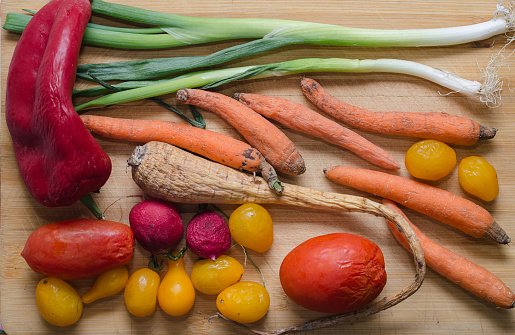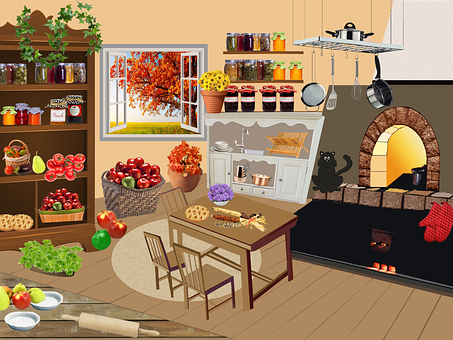MAINTENANCE OF GOOD HEALTH

FOOD SPOILAGE.
Food spoliage is a state in which food has gone bad and is usually dangerous to eat. Foods spoil in many ways and are caused by different factors.
The following are signs that indicate spoilage in foods.
- Moulds- soft greenish growth on food.
Change in colour - when the colour of a food changes.
Foam - whitish bubbles that appear on surface of food,
Bad smell - when the food gives off a bad scent.
Slimy - when food becomes sticky.
Bacteria: They are small organisms that live mostly on protein matter.
Enzymes: They are chemical (complex) substances present in all living things. Changes in foods, such as ripening of fruits and vegetables even after harvesting, are the action of enzymes. Beyond a certain point, they cause food to spoil. Low temperatures slow down enzyme action, but destroyed by long boiling.
Moulds: They are simple plants that appear mostly on sweet foods, e.g. cakes, cheese, kenkey.
Yeast:They are single cell organisms larger than bacteria and found mostly on sugary foods.
Oxidation: Exposing cut surfaces of food to react with oxygen. The food usually looses its colour, eg. banana, yam, pear, etc. Insects, Pests and Rodents can also cause spoilage in foods,
In addition to the factors above, certain acts by the caterer can also contribute to food spoilage. Such as;
- Covering of hot foods.
- Exposing food to bacteria action
- Improper heating of food.
- Handling foods after heating them.
Storing food for too long a time,
A. Protein Foods
- They give off unpleasant smell.
Milk curdles and turns sour.
Food changes colour.
Meat, fish and poultry rot.
B. Fruits and Vegetables.
- They become over-ripe (eg. pawpaw) or over-mature (eg. Okro, kontomire).
- They become soft and change colour.
- The flavour of the food changes or disappears.
Vegetables lose moisture and wilt.
C. Fats and Oils
- Fats grow or become mouldy.
-They become rancid.
- They have unpleasant smell,
Heating: This is the application of heat to foodstuff to destroy the food enzymes and micro-organisms.
Freezing: This is keeping the food at a low temperature by freezing below0°C in a freezer. The low temperature slows down bacteria action; it makesthem inactive.
Drying:This is the process by which the water content (moisture) of the food is reduced to create an unfavourable environment for the actions of food
enzymes and micro-organisms, hence preventing spoilage.

Food storage: is the act of keeping foods in good condition for some time before ultimate use without changing its form. Storage keeps the food for a short period. If the food is to be left for a long time, it must be preserved. Food items should be properly stored to prevent decay (food spoilage). Perishable foods can be stored in a refrigerator e.g. Meat, fish, tomato, milk,
vegetables, etc.
Non- perishable foods:can be stored in a kitchen cupboard or in containers with good fitting lids. E.g. rice, beans, garl, sugar, cooking oils, etc. Cool, dry places where air moves freely are the best places to store food items.

Food preservation is the act of keeping food for longer periods of time by giving it a special treatment. It may involve;
a). Changing the form of the foodstuff to another through processing (e.g. into powder)
b). The addition of other substances (e.g. brine).
C).Keeping the food in special containers or equipment (e.g. in a freezer).
Reasons for Preserving Food.
To prevent its spoilage.
To make it last longer.
To save money.
To maintain its nutritive value, To ensure its availability when out of season.
To avoid waste of food.
To be able to take care of emergencies.For easy transportation and storage.Cassava Maize
By drying /dehydration: e.g.
(A). Sun or solar drying - cassava, maize, legumes.
(B.) Oven drying - melon, legumes.
CVacuum drying - milk, egg.
(D). Spray drying - cocoa beverages, eggs.
Drying of Fish.
Use of safe chemicals (vinegar, Salt, sugar, phenols, etc.) e.g. Corn, fruits,
Meat.
By canning -e.g. fish, meat, vegetables
By bottling - e.g. fruits, fruit juices, puree.
By fermentation - e.g. melon seed (agushie), wines, locust bean seeds.
By smoking e.g. fish, meat.
By pickling e.g. onions, pig feet.
By freezing e.g. tomatoes, fish, poultry.
By oiling e.g. beans, egg.
in Ghana, most foods are preserved by drying
Most importantly let’s take our food storage and preservation very seriously, Because food also play a major part in human lives.
THANK YOU ALL FOR YOUR PRECIOUS TIME.
Thanks for sharing in our community. Keep on sharing for a brighter future.